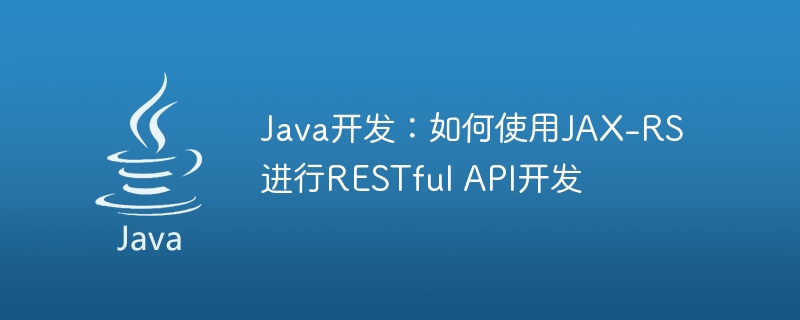Home >Java >javaTutorial >Java development: How to use JAX-RS for RESTful API development
Java development: How to use JAX-RS for RESTful API development
- WBOYWBOYWBOYWBOYWBOYWBOYWBOYWBOYWBOYWBOYWBOYWBOYWBOriginal
- 2023-09-21 14:45:36644browse

Java development: How to use JAX-RS for RESTful API development
Introduction:
With the development of the Internet and the increasing complexity of applications, the use RESTful APIs have become a common requirement in modern software development. JAX-RS is the abbreviation of Java API for RESTful Web Services, which provides a set of standards for creating and developing RESTful-style APIs. This article will introduce the basic concepts and usage of JAX-RS, and use specific code examples to show how to use JAX-RS for RESTful API development.
1. What is RESTful API?
REST (Representational State Transfer) is a software architecture style used to build distributed systems. RESTful API is an API designed based on REST principles. It accesses and operates resources by using verbs such as GET, POST, PUT, and DELETE in the HTTP protocol. The design principles of RESTful API include unified interface, stateless communication, cacheability, layered system and on-demand coding.
2. Basic concepts of JAX-RS
JAX-RS is part of Java EE, which provides a set of Java standards for developing RESTful APIs. The core of JAX-RS is a set of annotations used to mark the access methods and paths of resource classes and methods. The following are several commonly used JAX-RS annotations:
- @Path: used to mark the path of resource classes or methods. It can be defined on a class, method or parameter and is used to specify the URL of the resource.
- @GET, @POST, @PUT, @DELETE: used to mark the access method of the method. Correspond to the GET, POST, PUT and DELETE methods in the HTTP protocol respectively.
- @Produces, @Consumes: used to specify the content type of the request and response of the method. Can be a MIME type or Java class.
- @PathParam: used to extract parameter values from the URL path.
- @QueryParam: used to extract parameter values from the query string.
- @FormParam: used to extract parameter values from the form.
3. Steps to use JAX-RS for RESTful API development
The following will show a simple example to show how to use JAX-RS for RESTful API development. Suppose we want to develop a simple student management system, including the functions of adding, querying, updating and deleting students.
- Create a resource class (StudentResource.java), add the @Path annotation to specify the access path, and add the corresponding methods and annotations:
import javax.ws.rs.*;
import javax.ws.rs.core.MediaType;
@Path("/students")
public class StudentResource {
@GET
@Produces(MediaType.APPLICATION_JSON)
public List<Student> getAllStudents() {
// 获取所有学生的逻辑
}
@GET
@Path("/{id}")
@Produces(MediaType.APPLICATION_JSON)
public Student getStudentById(@PathParam("id") int id) {
// 根据id获取学生的逻辑
}
@POST
@Consumes(MediaType.APPLICATION_JSON)
public void addStudent(Student student) {
// 添加学生的逻辑
}
@PUT
@Path("/{id}")
@Consumes(MediaType.APPLICATION_JSON)
public void updateStudent(@PathParam("id") int id, Student student) {
// 根据id更新学生的逻辑
}
@DELETE
@Path("/{id}")
public void deleteStudent(@PathParam("id") int id) {
// 根据id删除学生的逻辑
}
}- Configure the project web.xml file that configures a JAX-RS Servlet container (such as Jersey) to handle RESTful requests:
<servlet>
<servlet-name>Jersey Servlet</servlet-name>
<servlet-class>org.glassfish.jersey.servlet.ServletContainer</servlet-class>
<init-param>
<param-name>jersey.config.server.provider.packages</param-name>
<param-value>com.example</param-value>
</init-param>
<load-on-startup>1</load-on-startup>
</servlet>
<servlet-mapping>
<servlet-name>Jersey Servlet</servlet-name>
<url-pattern>/api/*</url-pattern>
</servlet-mapping>- Build and deploy the project, and start the server. Now, we can access and test the RESTful API through HTTP requests.
4. Summary
This article introduces the basic concepts and steps of RESTful API development using JAX-RS, and provides a code example through a specific example. By using JAX-RS, we can quickly and easily build and develop RESTful-style APIs, providing powerful services and interfaces to front-end and other applications.
It should be noted that JAX-RS is only a way to develop RESTful API. There are other tools and frameworks to choose from, such as Spring MVC, Spring Boot, etc. Depending on the needs of the project and personal preferences, you can choose the appropriate tools and frameworks for API development.
Reference materials:
- JAX-RS (Java API for RESTful Web Services) official documentation: https://docs.oracle.com/javaee/7/tutorial/jaxrs. htm
- Building RESTful Web Services with JAX-RS (Java EE 7): https://www.baeldung.com/resteasy-tutorial
The above is the detailed content of Java development: How to use JAX-RS for RESTful API development. For more information, please follow other related articles on the PHP Chinese website!

